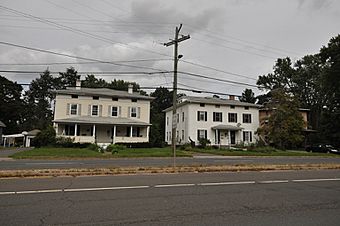Marlborough Street Historic District facts for kids
Quick facts for kids |
|
|
Marlborough Street Historic District
|
|
 |
|
| Location | 58, 64, 69, 70, 78, 88, & 92 Marlborough St., Portland, Connecticut |
|---|---|
| Area | 35 acres (14 ha) |
| Architect | Multiple |
| Architectural style | Greek Revival, Octagon, Late Victorian, Colonial Revival |
| NRHP reference No. | 12000130 |
| Added to NRHP | March 20, 2012 |
The Marlborough Street Historic District is a special area in Portland, Connecticut. It has some of the best 19th-century homes in the town. This district is found along Marlborough Street, just east of Main Street. It includes twelve houses built between 1847 and 1900. These homes show off many different building styles from that time. Because of its unique history and architecture, the district was added to the National Register of Historic Places in 1983.
What is the Marlborough Street Historic District?
Marlborough Street is a main road in Portland. It connects Portland to nearby Middletown and other towns to the east. Long ago, Main Street divided the town's rich and working-class areas. Portland's economy was mostly based on its large brownstone quarries. These quarries were located between Main Street and the Connecticut River.
Who Lived in These Historic Homes?
Marlborough Street became the place where important business leaders built their homes. This happened in the late 1800s. Many of the people who lived here owned or worked for the brownstone quarries. For example, members of the Brainerd family, who controlled the quarries, lived in these houses. Other company executives also built their homes here.
Amazing Architecture of the Houses
The Marlborough Street Historic District has many interesting buildings. Each one tells a story about the past.
- Hart-Jarvis House: This is the oldest house in the district, built around 1830. It is a Greek Revival style home. This means it looks a bit like ancient Greek temples. Later, a quarry owner named Erastus Brainerd Sr. lived here.
- Erastus Brainerd Jr.'s Villa: Erastus Brainerd Sr.'s son built a beautiful Italianate villa next door in 1852. This house is one of the most detailed buildings in the district. Some people think it might have been designed by a famous architect named Henry Austin.
- Unique Octagon Houses: Gilbert Stancliffe, another quarry executive, and his brother-in-law Joseph Williams built two very unusual homes. These are called octagon houses because they have eight sides! They are the only known pair of octagon houses inspired by Orson Squire Fowler. He was a person who believed octagon homes were healthier and more practical.
Most of these special buildings are on the northeastern side of Marlborough Street. Some houses on the south side of the street were later used for other purposes, like offices.



